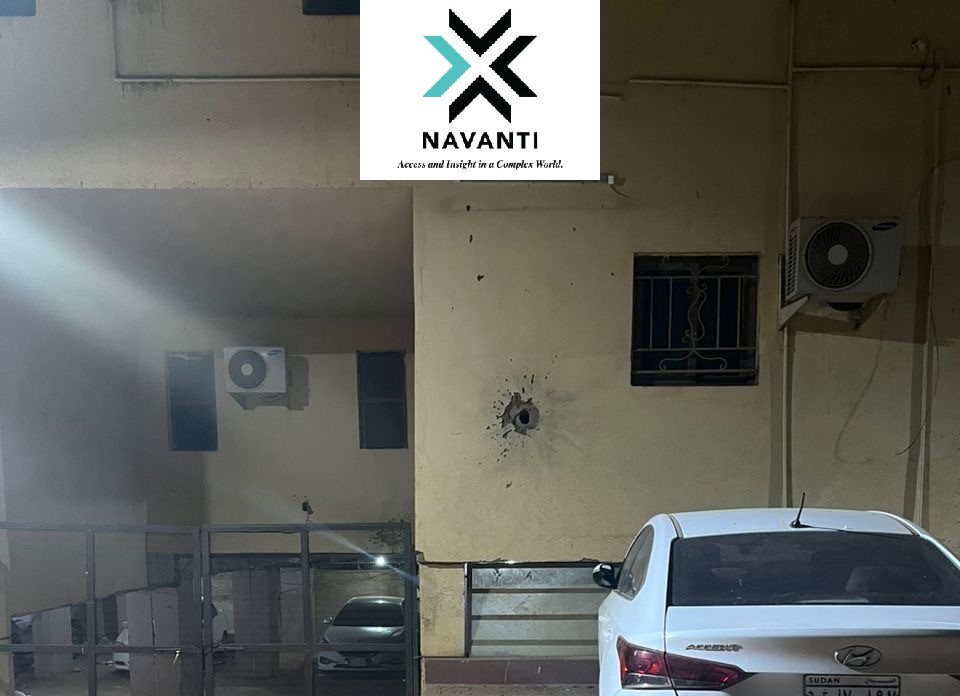What Our Analysts Are Reading – April, 2023
Navanti’s data collection and analysis are based on networks of on-the-ground researchers from all walks of life: journalists, academics, and humanitarian workers, to name a few. Our analysts also keep abreast of open source reports to inform their work. Below, these analysts have summarized and contextualized the most important pieces they have read and listened to over the past month.

Picture caption: A shell pierces through the facade of a building in Khartoum, Sudan, leaving behind a haunting reminder of the destruction and chaos that continue to afflict the region in May 2023
Armenia/Azerbaijan
Tensions along the Armenian-Azerbaijani border continue to fester over the Azerbaijani road block along the Lachin Corridor. The Corridor, which is the only link between Armenia and ethnic Armenian enclaves in the territory of the disputed Nagorno-Karabakh, has been the site of tense standoff since November. While the roadblock was originally set up under the auspices of an environmental protest, it has quickly morphed into a hot-button topic in both Armenia and Azerbaijan. The situation has deteriorated further in the month of April, to the point that international bodies have begun exploring options to mediate between Baku and Yerevan. This will continue to dominate public discourse in Azerbaijan and Armenia and will likely continue hindering any rapprochement between the two countries.
Guinea
Contract teachers in Guinea Conakry took to the streets from April 24 to 30, protesting months of no payment and lack of integration into the public school system and threatening new strikes. Teacher strikes are common in Guinea. In 2017, protests sparked by a strike turned deadly after the government announced it would dismiss or cut the salaries of junior teachers. The recurrence of teacher strikes speaks to larger, even endemic issues within the Guinea socio-political structure that have the potential to be a destabilizing element.
Haiti
Following months of worsening gang violence in Haiti’s capital of Port-au-Prince, residents began pushing back against gang control throughout the city in the second half of April. It has been estimated that gangs control 80% of Port-au-Prince, with a frightening uptick in violence accompanying the increase in prevalence of these groups. However, vigilante groups have begun organizing in the city to rid themselves of this scourge, building barricades and killing suspected gang members in a brutal fashion. In one neighborhood, a group captured, beat, and burned to death 13 suspected gangsters after they were taken from police custody. These events demonstrate the vicious circle of violence in Haiti that has undermined government capabilities and even basic civil society functions.
Sudan
Several weeks before Sudan descended into open conflict between Rapid Support Forces(RSF) paramilitary commander Hemedti and Sudanese Armed Forces (SAF) Commander-in-chief Abdulfattah al-Burhan, Kholood Khair of the Khartoum-based Confluence Advisory laid out in detail the increasingly tense situation in the country. He argued that the “transactional militarized politics” of Sudan had created a false dilemma for regional and international actors. In believing that they must variously placate either Burhan or Hemedti to stabilize the situation with an ill-fated security-focused approach, Khair posits that policy makers in capitals like Cairo, Abu Dhabi, and Washington precluded any common international approach, entrenching divisions and escalating the “tug of war” between the feuding generals. Distinct from the analyses in hindsight now proliferating in response to the crisis, Khair’s analysis reads as a stark warning for what ultimately came to pass in Sudan, and is a must-read backgrounder for the political roots of the current crisis.
The conflict in Sudan may threaten surrounding countries, many of which have dealt with their own conflicts and instability for decades. The increased proliferation of arms in Sudan, combined with the porous borders between countries in the region, could further escalate conflict in the surrounding countries if arms fell into the wrong hands, especially those of extremist groups such as Islamic State West Africa Province (ISWAP)and Boko Haram. The presence of external actors in Sudan and the surrounding areas, such as Russia and China, could also escalate the conflict, if their interests were to be threatened. Furthermore, the Lake Chad Basin and the Sahel both suffer from acute food insecurity, and have for decades. The escalating conflict in Sudan could only damage the already fragile situation, possibly leading to a worsened humanitarian crisis.
Furthermore, the authors of ‘Sudan’s Uprising: The Fall of a Dictator’ examine the factors that contributed to the 2018-2019 civilian protests in Sudan and ultimately contributed to the ousting of Omar al-Bashir in a coup d’état after 30 years of rule. The authors also evaluate the attempt to transition to civilian rule and the challenges faced, all of which factor into Sudan’s current crisis.
Yemen
The New York Times reported on the latest developments in Yemen’s peace talks, which have been ongoing for several months. The talks, which are being facilitated by the United Nations and the Sultanate of Oman, have seen some progress, with both sides agreeing to a ceasefire and prisoner exchange. However, there are still major obstacles to overcome, including the role of Iran in the conflict and the future political structure of Yemen. The humanitarian situation in Yemen remains dire, with millions of people in need of food, water, and medical assistance. Despite the challenges, there is hope that the peace talks could lead to a lasting resolution of the conflict.

